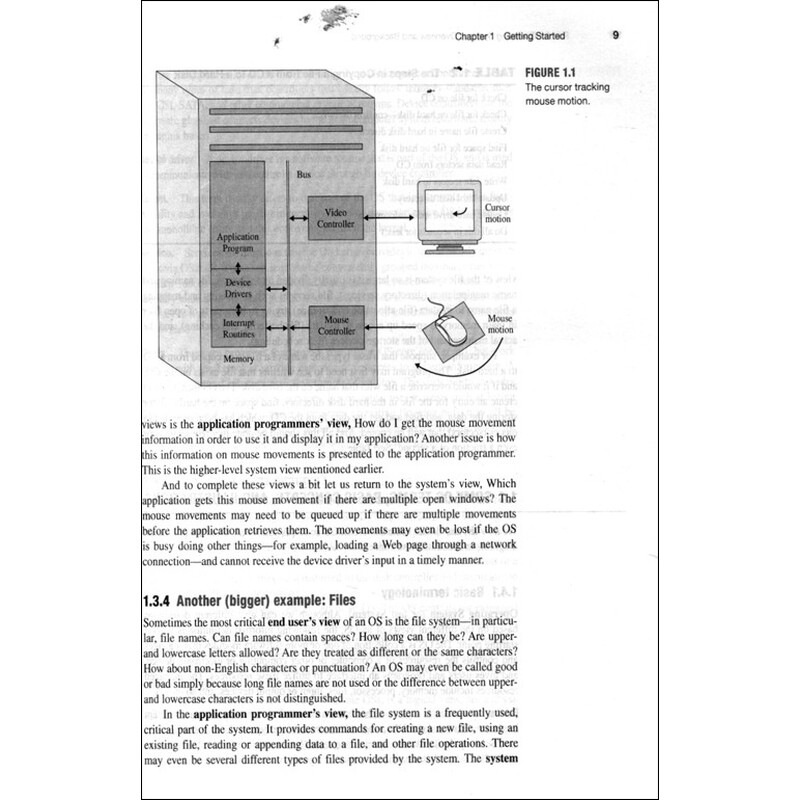书籍详情
![《操作系统实用教程:螺旋方法》[43M]百度网盘|亲测有效|pdf下载](/uploads/s0309/0fab2752-1384-4b8a-b9a1-c7a75da28062.jpg)
![《操作系统实用教程:螺旋方法》[43M]百度网盘|亲测有效|pdf下载](/uploads/s0309/0fab2752-1384-4b8a-b9a1-c7a75da28062.jpg)
操作系统实用教程:螺旋方法
- 出版社:机械工业出版社自营官方旗舰店
- 出版时间:2010-08
- 热度:10568
- 上架时间:2024-06-30 09:08:33
- 价格:0.0
书籍下载
书籍预览
免责声明
本站支持尊重有效期内的版权/著作权,所有的资源均来自于互联网网友分享或网盘资源,一旦发现资源涉及侵权,将立即删除。希望所有用户一同监督并反馈问题,如有侵权请联系站长或发送邮件到ebook666@outlook.com,本站将立马改正
内容介绍
编辑推荐
《操作系统实用教程:螺旋方法(英文版)》特色:对于所讨论的操作系统。书中适当介绍一些当时的行业历史,有时还涉及关键的企业或个人,这样能帮助学生更好地理解操作系统。涵盖在设备中的现代操作系统,而不仅仅是通常的计算机中的操作系统。讨论算法级解决方案,而没有列出实际代码。便于使用不同编程语言实现。每章末都有一些练习题,便于学生巩固所学知识。
内容简介
《操作系统实用教程:螺旋方法(英文版)》采用螺旋方法和深度导向方法讲解操作系统原理。首先介绍一些基本的背景和定义,然后描述一个非常简单的操作系统,之后将它演化为具有更多特性的更复杂的操作系统。这样循序渐进、逐步深入,可以使学生更透彻地理解操作系统的本质。
《操作系统实用教程:螺旋方法(英文版)》分为六个部分:第一部分介绍一些总体背景信息;第二部分采用螺旋方法,按照复杂度递增的次序。介绍五类操作系统;第三部分到第五部分采用深度导向方法详细地探讨操作系统的各个主题:从进程到内存管理,再到文件系统;第六部分通过三个实例更深入地研究这些系统的特性是如何实现的。
《操作系统实用教程:螺旋方法(英文版)》分为六个部分:第一部分介绍一些总体背景信息;第二部分采用螺旋方法,按照复杂度递增的次序。介绍五类操作系统;第三部分到第五部分采用深度导向方法详细地探讨操作系统的各个主题:从进程到内存管理,再到文件系统;第六部分通过三个实例更深入地研究这些系统的特性是如何实现的。
作者简介
Ramez Elmasri,得克萨斯大学阿灵顿分校教授。他于1980年在美国斯坦福大学获得计算机科学硕士和博士学位。其研究兴趣是传感器网络和RFID、生物信息介质、查询个性化和系统集成。
A. Gil Carrick,曾执教于得克萨斯大学阿灵顿分校。他是计算机科学荣誉协会Upsilon Pi Epsilon的成员。
David Levine,一直讲授操作系统、软件工程、网络和计算体系结构等课程。他的研究兴趣包括移动计算、移动对象和分布式计算。
A. Gil Carrick,曾执教于得克萨斯大学阿灵顿分校。他是计算机科学荣誉协会Upsilon Pi Epsilon的成员。
David Levine,一直讲授操作系统、软件工程、网络和计算体系结构等课程。他的研究兴趣包括移动计算、移动对象和分布式计算。
前言/序言
We have long felt that the traditional approach to teaching about Operating Systems(OSsl was not the best approach .The purpose of this book is to support a difrerent approach to this task When studying any complex domaln of knowledge,the order in which one learns the hierarchy Of principles,laws,ideas,and concepts carl make the process easier or more difficult.The most common technique is to partition the subject into major topics and then stody each one in great detail For 0Ss,this has traditionally meant that after a brief in t~oducfion to some terms and an overview,astudent studied isolated topics in depthproeesses and process management.
